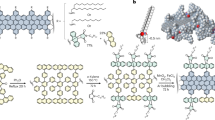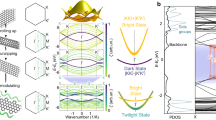Abstract
Understanding how the mechanical behaviour of materials deviates at the nanoscale from the macroscopically established concepts is a key challenge of particular importance for graphene, given the complex interplay between its nanoscale morphology and electronic properties1,2,3,4,5. In this work, the (sub)nanometre-wavelength periodic rippling of suspended graphene nanomembranes has been realized by thermal strain engineering and investigated using scanning tunnelling microscopy. This allows us to explore the rippling of a crystalline membrane with wavelengths comparable to its lattice constant. The observed nanorippling mode violates the predictions of the continuum model6, and evidences the breakdown of the plate idealization7 of the graphene monolayer. Nevertheless, microscopic simulations based on a quantum mechanical description of the chemical binding accurately describe the observed rippling mode and elucidate the origin of the continuum model breakdown. Spatially resolved tunnelling spectroscopy measurements indicate a substantial influence of the nanoripples on the local electronic structure of graphene and reveal the formation of one-dimensional electronic superlattices.
This is a preview of subscription content, access via your institution
Access options
Subscribe to this journal
Receive 12 print issues and online access
$259.00 per year
only $21.58 per issue
Buy this article
- Purchase on SpringerLink
- Instant access to full article PDF
Prices may be subject to local taxes which are calculated during checkout




Similar content being viewed by others
References
Katsnelson, M. I. & Geim, A. K. Electron scattering on microscopic corrugations in graphene. Phil. Trans. R. Soc. A 366, 195–204 (2008).
Vazquez de Parga, A. L. et al. Periodically rippled graphene: Growth and spatially resolved electronic structure. Phys. Rev. Lett. 100, 056807 (2008).
de Juan, F., Cortijo, A., Vozmediano, M. A. H. & Cano, A. Aharonov–Bhom interferences from local deformations in graphene. Nature Phys. 7, 810–815 (2011).
Levy, N. et al. Strain-induced pseudo-magnetic fields greater than 300 Tesla in graphene nanobubbles. Science 329, 544–547 (2010).
Ni, G. X. et al. Quasi periodic nanoripples in graphene grown by chemical vapor deposition and its impact on charge transport. ACS Nano 6, 1158–1164 (2012).
Bao, W. et al. Controlled ripple texturing of suspended graphene and ultrathin graphite membranes. Nature Nanotech. 4, 562–566 (2009).
Zhang, D. B., Akatyeva, E. & Dumitrica, T. Bending ultrathin graphene at the margins of continuum mechanics. Phys. Rev. Lett. 106, 255503 (2011).
Kim, E. & Castro-Neto, A. H. Graphene as an electronic membrane. Europhys. Lett. 84, 57007 (2008).
Isacsson, A., Jonsson, L. M., Kinaret, J. M. & Jonson, M. Electronic superlattices in corrugated graphene. Phys. Rev. B 77, 035423 (2008).
Teague, M. L. et al. Evidence of strain induced local conductance modulations in single-layer graphene on SiO2 . Nano Lett. 9, 2542–2548 (2009).
Fasolino, A., Los, J. H. & Katsnelson, M. I. Intrinsic ripples in graphene. Nature Mater. 6, 858–861 (2007).
Deshpande, A., Bao, W, Miao, F., Lau, C. N. & LeRoy, B. J. Spatially resolved spectroscopy of monolayer graphene on SiO2 . Phys. Rev. B 79, 205411 (2009).
Brey, L. & Palacios, J. J. Exchange-induced charge inhomogeneities in rippled neutral graphene. Phys. Rev. B. 77, 041403(R) (2008).
Park, C. H., Yang, L., Son, Y. W., Cohen, M. L. & Louie, S. G. Anisotropic behavior of massless Dirac fermions in graphene under periodic potentials. Nature Phys. 4, 213–217 (2008).
Boukhvalov, D. W & Kastnelson, M. I. Enhancement of chemical activity in corrugated graphene. J. Chem. Phys. C 113, 14176–14168 (2009).
Cerda, E. & Mahadevan, L. Geometry and physics of wrinkling. Phys. Rev. Lett. 90, 074302 (2003).
Pai, W. W. et al. Evolution of two-dimensional wormlike nanoclusters on metal surfaces. Phys. Rev. Lett. 86, 3088–3091 (2001).
Rasool, H. I. et al. Atomic-scale characterization of graphene on copper (100) single crystals. J. Am. Chem. Soc. 133, 12536–12543 (2011).
Rutter, G. M. et al. Scattering and interference in epitaxial graphene. Science 317, 219–222 (2007).
Tapaszto, L., Dobrik, G., Lambin, P. & Biro, L. P. Tailoring the atomic structure of graphene nanoribbons by scanning tunneling microscope lithography. Nature Nanotech. 3, 397–401 (2008).
Hwang, C. et al. Initial stage of graphene growth on a Cu substrate. J. Phys. Chem. C 115, 22369–22374 (2011).
Wofford, J. M., Nie, S, McCarty, K. F., Bartelt, N. C. & Dubon, O. D. Graphene islands on Cu foils: The interplay between shape, orientation, and defects. Nano Lett. 10, 4890–4896 (2010).
Chen, C. C. et al. Raman spectroscopy of ripple formation in suspended graphene. Nano Lett. 9, 4172–4176 (2009).
Zakharenko, K. V., Katsnelson, M. I. & Fasolino, A. Finite temperature lattice properties of graphene beyond the quasiharmonic approximation. Phys. Rev. Lett. 102, 046808 (2009).
Wang, Z. & Devel, M. Periodic ripples in suspended graphene. Phys. Rev. B 83, 125422 (2011).
Tsoukleri, G. et al. Subjecting a graphene monolayer to tension and compression. Small 5, 2397–2402 (2009).
Frauenheim, D., Köhler, T., Seifert, Th. & Kaschner, G. Construction of tight-binding-like potentials on the basis of density-functional theory: Application to carbon. Phys. Rev. B 51, 12947–12957 (1995).
Koenig, S. P., Bodetti, N. G., Dunn, M. L. & Bunch, J. S. Ultrastrong adhesion of graphene membranes. Nature Nanotech. 6, 543–546 (2011).
Koshkinen, P. & Kit, O. O. Approximate modeling of spherical membranes. Phys. Rev. B 82, 235420 (2010).
Xu, K., Cao, P. & Heath, J. R. Scanning tunneling microscopy characterization of the electrical properties of wrinkles in exfoliated graphene mono layers. Nano Lett. 9, 4446–4451 (2009).
Acknowledgements
The experimental work has been conducted within the framework of the Korean–Hungarian Joint Laboratory for Nanosciences through the Converging Research Center Program (2010K000980). L.T. acknowledges OTKA grant PD 91160 and the Bolyai fellowship and is grateful to the Alexander von Humboldt Foundation. P.N-I. and L.P.B. acknowledge OTKA grant K 101599. T.D. acknowledges NSF CAREER Grant CMMI-0747684.
Author information
Authors and Affiliations
Contributions
L.T. conceived and designed the experiments. L.T. and P.N-I. performed the STM experiments. S.J.K. and C.H. performed the growth experiments. T.D. provided the simulation results. L.T., T.D. and L.P.B. analysed the data. L.T. and T.D. wrote the paper. All of the authors discussed the results and commented on the manuscript.
Corresponding author
Ethics declarations
Competing interests
The authors declare no competing financial interests.
Supplementary information
Supplementary Information
Supplementary Information (PDF 1066 kb)
Rights and permissions
About this article
Cite this article
Tapasztó, L., Dumitrică, T., Kim, S. et al. Breakdown of continuum mechanics for nanometre-wavelength rippling of graphene. Nature Phys 8, 739–742 (2012). https://doi.org/10.1038/nphys2389
Received:
Accepted:
Published:
Issue date:
DOI: https://doi.org/10.1038/nphys2389
This article is cited by
-
Free-electron interactions with van der Waals heterostructures: a source of focused X-ray radiation
Light: Science & Applications (2023)
-
Atomscopic of ripple origins for two-dimensional monolayer transition metal dichalcogenides
Nano Research (2023)
-
Strong and Localized Luminescence from Interface Bubbles Between Stacked hBN Multilayers
Nature Communications (2022)
-
Large-area nanoengineering of graphene corrugations for visible-frequency graphene plasmons
Nature Nanotechnology (2022)
-
Inhomogeneous strain and doping of transferred CVD-grown graphene
Rare Metals (2022)



